Protein synthesis Study guides, Class notes & Summaries
Looking for the best study guides, study notes and summaries about Protein synthesis? On this page you'll find 16399 study documents about Protein synthesis.
Page 3 out of 16.399 results
Sort by
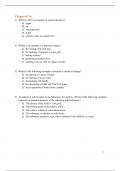
-
Test Bank for General, Organic, & Biological Chemistry, 5th Edition by Janice Smith
- Exam (elaborations) • 952 pages • 2023
-
- $39.99
- 2x sold
- + learn more
Test Bank for General, Organic, & Biological Chemistry 5e 5th Edition by Janice Smith. ISBN 2023 Full Chapters test bank included Chapter 1: Matter and Measurement Chapter 2: Atoms and the Periodic Table Chapter 3: Ionic Compounds Chapter 4: Covalent Compounds Chapter 5: Chemical Reactions Chapter 6: Energy Changes, Reaction Rates, and Equilibrium Chapter 7: Gases, Liquids, and Solids Chapter 8: Solutions Chapter 9: Acids and Bases Chapter 10: Nuclear Chemistry Chapter 11: Introd...
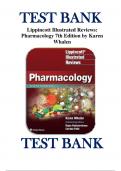
-
Test Bank For Lippincott Illustrated Reviews: Pharmacology 7th Edition by Karen Whalen 9781496384133 Chapter 1-47 Complete Guide .
- Exam (elaborations) • 511 pages • 2023
-
Available in package deal
-
- $19.99
- 2x sold
- + learn more
Test Bank For Lippincott Illustrated Reviews: Pharmacology 7th Edition by Karen Whalen 4133, X , 6113, 6 1: Pharmacokinetics 2: Drug–Receptor Interactions and Pharmacodynamics 3: The Autonomic Nervous System 4: Cholinergic Agonists 5: Cholinergic Antagonists 6: Adrenergic Agonists 7: Adrenergic Antagonists 8: Drugs for Neurodegenerative Diseases 9: Anxiolytic and Hypnotic Drugs 10: Antidepressants 11: Antipsychotic Drugs 12: Drugs for Epilepsy 13: Anesthetics 14: Opioids 15: CNS Stimulants 16:...
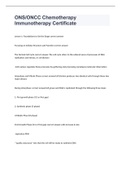
-
ONS/ONCC Chemotherapy Immunotherapy Certificate exam 2022/2023 with 100% correct answers
- Exam (elaborations) • 28 pages • 2022
-
Available in package deal
-
- $11.49
- 19x sold
- + learn more
Lesson 1: Foundations to Set the Stage ... Focusing on Cellular Structure and Function ... The Normal Cell Cycle -The cell cycle refers to the ordered seres of processes of DNA replication and mitosis, or cell division -Cell nucleus regulates these processes by gathering and processing complexes molecular information Interphase and Mitotic Phase Cell division produces two identical cells through these two major phases During interphase: Cell grows and DNA is r...
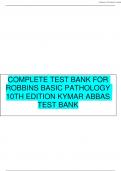
-
Robbins Basic Pathology 10th Edition Kymar Abbas Test Bank
- Exam (elaborations) • 153 pages • 2023
-
- $17.99
- 1x sold
- + learn more
1 The nucleus , which is essential for function and survival of the cell. A) is the site of protein synthesis B) contains the genetic code C) transforms cellular energy D) initiates aerobic metabolism 2 Although energy is not made in mitochondria, they are known as the power plants of the cell because they: A) contain RNA for protein synthesis. B) utilize glycolysis for oxidative energy. C) extract energy from organic compounds. D) store calcium bonds for muscle contractions. 3 Althoug...
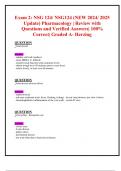
-
Exam 2: NSG 124/ NSG124 (NEW 2024/ 2025 Update) Pharmacology | Review with Questions and Verified Answers| 100% Correct| Graded A- Herzing
- Exam (elaborations) • 32 pages • 2024
-
Available in package deal
-
- $11.49
- 1x sold
- + learn more
Exam 2: NSG 124/ NSG124 (NEW 2024/ 2025 Update) Pharmacology | Review with Questions and Verified Answers| 100% Correct| Graded A- Herzing QUESTION Vancomycin- inhibits cell wall synthesis - treats MRSA, C. difficile - monitor renal function with creatinine levels - obtain trough level (30 minutes prior to next dose) - infuse slowly, at least over 60 minutes QUESTION Vancomycin adverse effects Answer: - nephrotoxicity - red man syndrome (rash, hives, flushing, it...
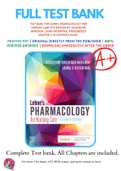
-
Test Bank For Lehne's Pharmacology for Nursing Care 11th Edition By Jacqueline Burchum; Laura Rosenthal 9780323825221 Chapter 1-112 Complete Guide .
- Exam (elaborations) • 524 pages • 2023
-
- $33.12
- 6x sold
- + learn more
Test Bank For Lehne's Pharmacology for Nursing Care 11th Edition By Jacqueline Burchum; Laura Rosenthal 5221, 2 , 5269, 5 1. Orientation to Pharmacology 2. Application of Pharmacology in Nursing Practice 3. Drug Regulation, Development, Names, and Information 4. Pharmacokinetics 5. Pharmacodynamics 6. Drug Interactions 7. Adverse Drug Reactions and Medication Errors 8. Individual Variation in Drug Responses 9. Genetic and Genomic Considerations 10. Introduction to...
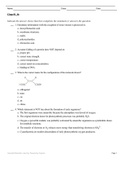
-
Test Bank for Lehninger Principles of Biochemistry, 8th Edition by David L. Nelson
- Exam (elaborations) • 753 pages • 2022
-
- $39.99
- 39x sold
- + learn more
Test Bank for Lehninger Principles of Biochemistry 8e 8th Edition by David L. Nelson, Michael M. Cox. ISBN-13: 8002 Full chapters test bank PDF 1. The Foundations of Biochemistry I STRUCTURE AND CATALYSIS 2. Water, the Solvent of Life 3. Amino Acids, Peptides, and Proteins 4. The Three-Dimensional Structure of Proteins 5. Protein Function 6. Enzymes 7. Carbohydrates and Glycobiology 8. Nucleotides and Nucleic Acids 9. DNA-Based Information Technologies 10. Lipids 11. Biolog...
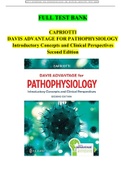
-
DAVIS ADVANTAGE FOR PATHOPHYSIOLOGY Introductory Concepts and Clinical Perspectives Second Edition CAPRIOTTI TEST BANK / Verified Answers From Publisher
- Exam (elaborations) • 476 pages • 2022
-
- $16.99
- 5x sold
- + learn more
Multiple Choice Identify the choice that best completes the statement or answers the question. 1. Which statement regarding the sodium–potassium pump is correct? 1. The cell’s plasma membrane is more soluble to sodium ions than potassium ions. 2. The concentration of sodium ions should be higher inside the cell compartment. 3. The concentration of potassium ions should be higher outside the cell compartment. 4. The active transport involves pumping out three sodium ions and pumping i...
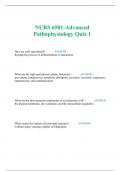
-
NURS 6501-Advanced Pathophysiology Quiz 1
- Exam (elaborations) • 27 pages • 2023
-
- $10.49
- 1x sold
- + learn more
NURS 6501-Advanced Pathophysiology Quiz 1 How are cells specialized? - ANSWER through the process of differentiation or maturation What are the eight specialized cellular functions? - ANSWER movement, conductivity, metabolic absorption, secretion, excretion, respiration, reproduction, and communication What are the three general co...

-
Portage Learning: Microbiology Final Exam Set Already Passed
- Exam (elaborations) • 40 pages • 2022
- Available in package deal
-
- $10.49
- 18x sold
- + learn more
Portage Learning: Microbiology Final Exam Set Already Passed Microbiology is the study of what? Microbiology is the study of microbes (microorganisms and viruses) and their biological processes. What is the smallest biological unit of life? A cell What is a macromolecule? A macromolecule is classified as a complex molecule that is composed from smaller subunits. What are the four main types of macromolecules? Proteins, nucleic acids, lipids and carbohydrates What various functions do protein...

Did you know that on average a seller on Stuvia earns $82 per month selling study resources? Hmm, hint, hint. Discover all about earning on Stuvia


